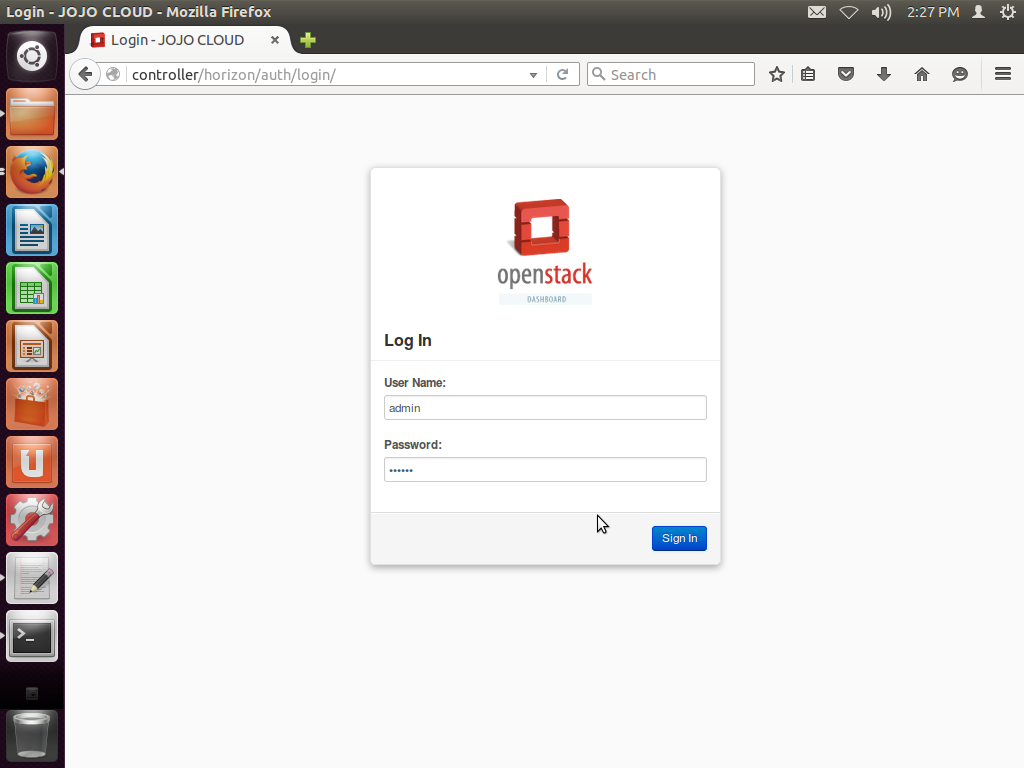
- #CONJURE UP OPENSTACK DEFAULT LOGIN INSTALL#
- #CONJURE UP OPENSTACK DEFAULT LOGIN UPDATE#
- #CONJURE UP OPENSTACK DEFAULT LOGIN FREE#
I could have as well omitted the version number and allow Juju to automatically get the latest available version.

You’ve noticed that I use version 101 of the canonical-kubernetes bundle.
#CONJURE UP OPENSTACK DEFAULT LOGIN UPDATE#
Then update the juju-kubernetes LXD profile: $ lxc profile edit "juju-kubernetes" < juju-lxd-profile.yamlįinal step, deploy Kubernetes already! $ juju deploy canonical-kubernetes-101 Make sure that you have generated an SSH key pair for user “ubuntu”, before you execute the following one-liner: $ sed -ri ~/.ssh/id_rsa.pub)'" juju-lxd-profile.yaml Path: /sys/module/apparmor/parameters/enabled Path: /sys/module/nf_conntrack/parameters/hashsize Linux.kernel_modules: ip_tables,ip6_tables,netlink_diag,nf_nat,overlay Create a new YAML file juju-lxd-profile.yaml with the following configuration: name: juju-kubernetes So, Juju not only provides isolation through models, but ensures that if a model requires customized LXD containers, no other existing or future LXD profiles will be affected.įor Kubernetes, we will customize the juju-kubernetes profile to enable privileged machine containers and add an SSH key to it. It will also create a new LXD profile, associated with this model: $ lxc profile list Juju will automatically switch the active model to “kubernetes”. Kubernetes* localhost/localhost available 0 - admin never connected Model Cloud/Region Status Machines Cores Access Last connectionĬontroller localhost/localhost available 1 - admin just nowĭefault localhost/localhost available 0 - admin just now Let’s create a new model for our k8s deployment: $ juju add-model kubernetes The juju controller is now instantiated! As part of the process, two new LXD profiles have been created: $ lxc profile list $ sudo add-apt-repository ppa:ubuntu-lxc/lxd-stable -y Let’s SSH into our freshly deployed Xenial, using user ubuntu and update the critical components, LXD and Juju, to their latest stable versions: $ sudo add-apt-repository ppa:juju/stable -y

We will also leverage Juju and the Charmed Kubernetes bundle - yes, the same bundle that we use for production deployments on public cloud and bare-metal. We will be using machine containers ( LXD) since they provide virtual machine operations semantics, and bare metal performance. Moreover, MAAS will serve as DHCP server and DNS. I have also configured a Linux bridge (br0) and have attached the NIC (eth0) to it, using MAAS’ network configuration capabilities. As I am writing this, I am using MAAS to deploy Ubuntu 16.04.3 on such a machine.
#CONJURE UP OPENSTACK DEFAULT LOGIN FREE#
You will need a machine equipped with at least 4 CPU cores, 16GB RAM,100GB free disk space, preferably SSD and one NIC.

The worker nodes real estate needs to be elastic, allowing to add/remove nodes on demand, without disruption of the existing services. The control plane needs to be containerized and retain the same characteristics as a production environment (observability, scalability, upgradability, etc). Here is the task at hand: deploy Kubernetes on a bare metal server.

#CONJURE UP OPENSTACK DEFAULT LOGIN INSTALL#
Whether the substrate is a public cloud (AWS, Azure, GCP, etc) private virtualized environments (VMware) or bare metal, conjure-up will allow you to quickly install a fully functional, production-grade Kubernetes.īut what if you wanted to delve a bit more into the details of the process? What if you wanted to use directly the core tools of the conjure-up apparatus? A few years ago, the simplest method to deploy and operate Kubernetes on Ubuntu was with conjure-up.


 0 kommentar(er)
0 kommentar(er)
